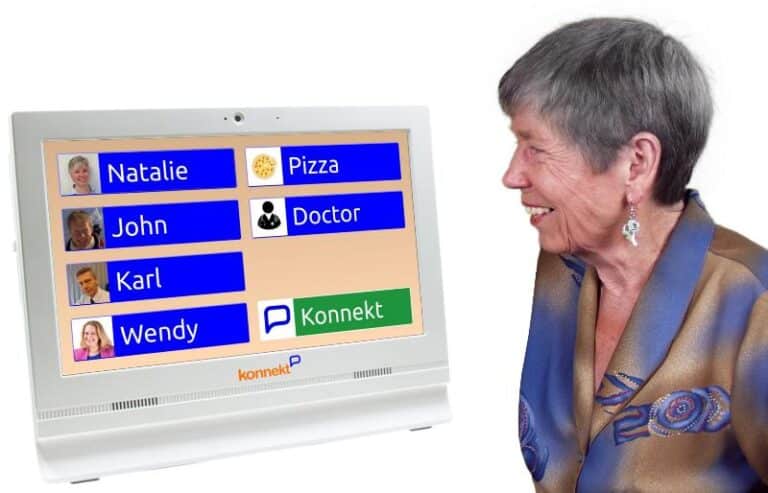In today’s fast-moving digital age, teaching technology to the elderly is essential. Although it might sounds difficult at first, there are in fact many simple and effective ways to do that.
Examples of teaching technologies to seniors effectively
- Set aside the time, perhaps with a diary entry or calendar invite – make sure you create the space in your week
- Allow plenty of time for hands-on practice
- Break the process into small steps
- Write up easy-to-follow instructions that can be reviewed at any time
- Post the instructions in a memorable spot (like on the fridge door)
- Select easy-to-use technology that does one thing well
But why are we doing this?
According to recent reports by the Australian Bureau of Statistics (ABS), approximately 4.4 million Australians over the age of 65 use the internet, which represents 76% of the senior population.
However, there is still a significant portion of older Australians who do not have digital skills. There are around 25% of people aged over 65 having never used the internet at all, despite the fact that it can largely benefit their life.

With the increasing importance of digital skills in daily life, those who do not have these skills risk being excluded from opportunities and resources that are available online.
What’s more, technology can actually enhance the lives of seniors by enabling them to stay connected with friends and family, access health resources and services, and participate in activities that they enjoy.
Examples of digital technology available to seniors include:
- Online health resources
- Platforms facilitating online shopping and delivery of other services
- Video-calling devices (check out the Konnekt Videophone and Captioning Videophone, crafted especially for the elderly)
- Personal alarms and home security systems
In this article, we’ll take a look at the benefits of teaching technology to the elderly, and explore a range of these trips in more depth.
Getting started with technology

When we think of older adults and technology, we often don’t think of the two going hand in hand. We imagine our parents or grandparents struggling to use their new phone or tablet and their desire to revert to their landline.
While this can be true for many older adults, a large number of seniors are eager to learn and use new technology. However, this can be easier said than done: Teaching new technology can take time, effort and patience to understand the requirements of the user.
Research published by the Australian Communications and Media Authority (ACMA) has shown that while more older Australians are now engaging in digital behaviours than ever before, they still consider technology challenging, hard to use and difficult to keep up with.
What’s more, the American organization AARP (formerly American Association of Retired Persons) recently reported that almost 30% of adults aged 65 and older in the United States do not use the internet.
Still, things are starting to shift. Having lived in isolation and away from loved ones as a result of the COVID-19 pandemic, many elderly people are now beginning to understand the roles technology can have in keeping them connected to friends and family.
What is the importance of staying connected with technology as we age?
Staying connected with technology as we age is important for many reasons, including:
- Social connectedness: Technology can help older adults stay connected with family, friends, and other members of their community and help to combat social isolation – an issue that’s prevalent in older communities
- Access to resources and services: Technology provides access to a wealth of resources and services that can be particularly useful for older adults, including online shopping, banking, and healthcare services
- Cognitive stimulation: Learning and using new technology can help to keep the brain active and engaged, which can help to prevent cognitive decline and keep the mind active
- Safety and security: Technology can also help older adults to stay safe and secure, particularly if they live alone – for example, home security systems, video-calling devices, and other emergency response systems can provide peace of mind and quick help in case of emergency
- Independence: Technology can also help older adults maintain their independence by providing access to information and resources that can help them to manage their daily lives more effectively
Benefits of technology for the elderly
The major benefits of technology for the elderly include:
- Increased social connection
- Access to beneficial digital resources
- A feeling of remaining “current” and connected to cultural shifts
It’s important to note that when we think of older adults and technology, we often don’t think of the two going hand-in-hand.

Challenges of teaching technologies to the elderly
Overall, the major challenges involved in teaching technologies to the elderly include:
- Lack of experience with input devices (keyboards, small touchscreens)
- Difficulty using small, quiet and fiddly appliances or tablets
- Lack of experience with operating systems, apps and common software
- Difficulty remembering instructions due to MCI or simply old age
- Fear of technology, fear of looking stupid, frustration, distrust, desire for privacy
According to a report by the Good Things Foundation, a UK-based charity that works to promote digital inclusion, around 4.5 million people aged 55 and over in the UK lack basic digital skills, often due to the aforementioned factors. This represents around 17% of the total population in this age group.
Therefore, selecting the right technological devices for use by your elderly loved one becomes a decision of particular importance.
Choosing the right devices
When selecting technology for an older person to use, it’s important to consider:
- Time and effort: Do you and your relative have the time and effort to learn a new technology?
- Requirements: Is the technology/device you’re purchasing the correct decision based on their requirements?
- Features and benefits: What features do the technology have that will solve the current needs and challenges?
- Dexterity and mobility: Is your relative able to navigate a new and unfamiliar technology?
- Appropriate based on individual needs: Does the device or technology suit the elderly person’s needs and abilities?
It’s also suggested that you look for the following characteristics of assistive technologies:
- Size: Is the device big enough that they will be able to use it without misplacing
- Font: Does the device have a big screen or can the font be made bigger if your relative has poor eyesight
- Volume: Can the volume be adjusted so your relative can hear if the device is ringing
- Location: Where does the device need to be placed to use – can it be mounted so it is not easily lost
- Maintenance: What support and maintenance does the device need? What is involved in the upkeep?
- Cost: How much is the cost of the new device? Is it an upfront or ongoing cost
Video calls
As a method of communication that’s simple and engaging, video calls can be the perfect solution to helping your loved one navigate new technology with ease.
However, most video-calling apps and the smartphones and tablets that they run on can be complicated to use, small and fiddly, and require charging. Fortunately, there are solutions that address these limitations.
Konnekt Videophone as an alternative communication device
Technology like the Konnekt phone is a wonderful solution. Easy to learn and simple to use, they can even help improve cognitive function in as little as 6 weeks.
Key benefits include:
- No skills required – no keyboard or mouse, and no pop-ups
- Calling mobiles, tablets, computers, landlines, GPs, family members, and more – everything is possible
- An “always-on” function – no need to press a power button
- One touch to call, with a special “zero-touch” function when answering a carer’s call
- Allowing the user to see who’s calling

Are you looking for an easy-to-use device that covers all bases? Welcome to video calls via Konnekt!
To find out more about our products and to better understand how you can help the people in your life manage their dementia diagnosis, consider visiting our online library of educational materials.
References
- “Building a Digital Nation”, Good Things Foundation
- “Digital lives of older and younger Australians revealed in ACMA report”, Australian Communications and Media Authority (ACMA)
- “Household use of information technology”, Australian Bureau of Statistics (ABS)
- “Using Technology to Assist with Caregiving: Carers Are Interested”, AARP
